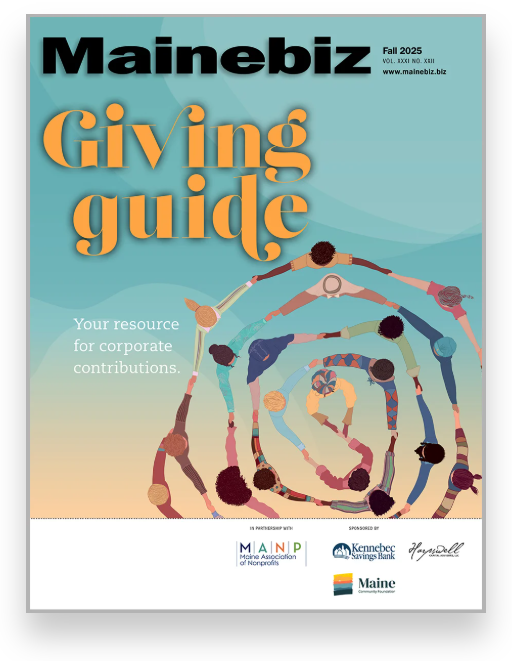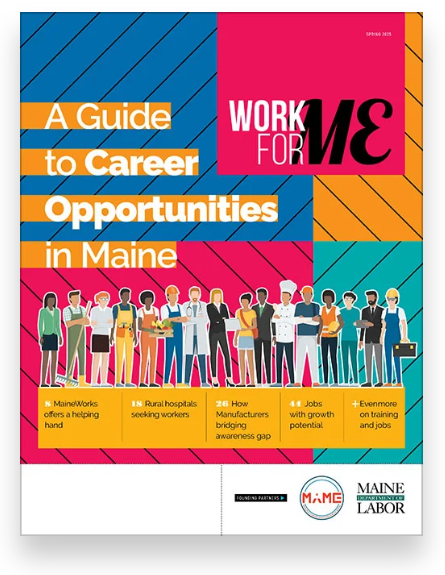Processing Your Payment
Please do not leave this page until complete. This can take a few moments.
- News
-
Editions
View Digital Editions
Biweekly Issues
- November 03, 2025
- October 20, 2025
- October 6, 2025
- September 22, 2025
- September 8, 2025
- August 25, 2025
- + More
Special Editions
- Lists
- Viewpoints
- Our Events
- Calendar
- Biz Marketplace
The $15 million question | Midcoast boat builders and composite companies are watching how the state spends a $15 million federal grant
Martin Grimnes, owner of composite pier and piling maker Harbor Technologies in Brunswick, would love to bring in consultants to teach his employees the newest, fastest and most environmentally friendly ways to build with composite materials. Todd French, co-owner of boat building company French & Webb Inc. in Belfast, would like to see Maine send stronger delegations to national and global trade shows to boost its profile as a leading manufacturer of custom recreational vessels.
Throughout May, industry leaders have been offering those views and many more to the newly formed North Star Alliance, an oversight board made up of state officials and industry representatives that has the job of dividing up a $15 million U.S Department of Labor Workforce Innovation Regional Economic Development grant Maine received in February. Board members aren't revealing much at this early stage about how they'll spend the money, but Maine boat builders and composites experts agree that the grant is an important opportunity for growth in their industries. "I think it's going to have a huge impact," says Grimnes. "There's going to be so much dialogue between companies. It's really going to energize the industry."
The midcoast stands to benefit in particular, with its concentration of boat building and composites companies ˆ boat building and related trades account for roughly 38% of the economy in the Boothbay area and 12% in Rockland and surrounding communities, according to the Maine Marine Trades Association. One of the grant's stated focuses is to mitigate job losses associated with the closing of the Brunswick Naval Air Station. Through various means, the money is expected to fund employee training, research and development, marketing, and capital projects over a three-year period, bringing ˆ its backers hope ˆ economic growth along the coast.
But mingled with the excitement is concern over whether enough money will find its way through complex channels to make a real difference in the marketplace. Christina Sklarz-Libby, the newly appointed program manager for the grant, will have the challenging task of coordinating the many interested groups, and in early May, the North Star Alliance was holding daily meetings to hammer out the details for grant distribution. Sklarz-Libby expects a blueprint and more public information in "several weeks."
"At first blush $15 million sounds like a big number, but there are so many worthwhile places that match the intent of the grant," says Sklarz-Libby, who was hired from her post as a midcoast business development specialist at the Department of Economic and Community Development.
Creating the budget
The North Star Alliance, appointed by Gov. John Baldacci's office, includes representatives from the state Department of Labor, the Department of Economic and Community Development and the University of Maine, and industry groups like the Maine Marine Trade Association, Maine Built Boats and the Maine Composites Alliance. Along with Sklarz-Libby, Henry Renski of the Department of Labor will serve as deputy program manager, and the group is seeking an industry coordinator to bring elements of the traditionally independent trades together.
The WIRED grants, introduced this year, are designed to boost skill levels and job growth in targeted regional industries. Maine's grant proposal, as drafted by a team from the public and private sectors, lays out broad guidelines for funding "four pillars" of economic growth in the composites and boat building sectors, with the ultimate goal of creating 2,000 jobs. It proposes $6.3 million for workforce development through the state Department of Labor, the university system and apprenticeship programs. Another $5.3 million is proposed for capitalization, which includes seed money for grant applicants through the DECD and the Maine Technology Institute. The University of Maine's Advanced Engineered Wood Composites Center in Orono, which partners with private industry to design and test composite materials, is slated to receive $1.8 million to pay for research and development activity. Money also will be set aside for marketing, both to seek out new opportunities and raise awareness of Maine's product.
If it sounds complicated, that's because it is, says Sklarz-Libby and several other officials who declined to comment until the initial negotiations are complete. Because of that complexity, business owners are concerned that, amid the back-and-forth, too much money will go to administration or to analysis and research efforts that don't really match the market's needs. "I'd hate to see all the money just fall through the cracks," says Steve Hassett, who founded Custom Composite Technologies Inc. in Bath in 1999.
Grimnes, meanwhile, called for the spending to focus on "projects that turn into sales as fast as possible." He cited as examples bidding on contracts for military or passenger transport vessels and developing marine energy sources from wind and tides.
Still, business owners ˆ particularly in the bigger boat yards ˆ are upbeat about the balanced approach despite the complexities involved. "It's not just one thing that's needed. I think these four focuses are excellent," says Turner at Lyman-Morse.
In dealing with the grant's inherent complexity, one key for success will be finding an "awesome communicator" from the private sector to fill the role of industry coordinator, Turner says. The North Star Alliance also will launch a website to help disseminate information, says Sklarz-Libby.
But many business owners credit a trend of improving communication across the industries with putting Maine in a position to win the grant in the first place. (See "Down to the wire," page 21.) For example, the 2004 joint marketing effort dubbed Maine Built Boats has helped improve ties between companies, and John Kachmar, president of Wilbur Yachts in Southwest Harbor, cites use of the Internet and an increased willingness to share business practices as factors in the growing communication. The hard work of parceling out grant money and collaborating on new projects will only increase this trend, Kachmar says. "In the past, a couple companies have done a good job working together. Now it's the whole industry up and down the coast."
A shopping list
While business owners have different priorities for how they'd spend the money, a larger, skilled workforce is the most common refrain. Like Turner at Lyman-Morse, Hassett is frustrated by the difficulty of finding workers for his high-tech composites firm. "I don't even think high school guidance counselors know this exists as a career," he says.
Hassett currently employs five at his firm, which makes custom composite products for the marine industry, but says he could take on more five more and still have work unfinished at the end of the day. "We're only limited by the size of the workforce," Hassett says.
Todd French agreed, pointing in particular to a shortage of plumbing, electrical and navigational specialists in the boat-building industry. Boat building employs roughly 4,000 Mainers at about 450 companies, says Susan Swanton, director of the Maine Marine Trade Association in Portland. And while the U.S. Department of Labor specifies a goal of 2,000 jobs created from the grant's funding ˆ a "huge number," says Swanton ˆ some of those jobs may already be there waiting to be filled, say Turner, Hassett and French.
Technological know-how is also "desperately needed" in the state, according to Turner. While Maine turns out state-of-the-art boats, it does so only in small numbers and in the face of competition from other New England states, the Gulf Coast, Europe and Asia. Turner and Kachmar both want greater access to infusion technology, a means of molding composite materials in a vacuum that is faster and more environmentally sound than earlier methods.
Jock Williams, owner of John Williams Boat Co. on Mt. Desert Island, wants to see a composites supplier bring computer numerical control technology to the state. CNC machines use computer-guided drills to carve foam into exact molds for ship hulls and other applications. Williams has never employed the fast, precise technology because the nearest center he could find was in California, he says.
Yet the composites center at UMaine Orono can be a big part of the technological answer for its home state with the help of $1.8 million from the grant, says director Habib Dagher. The center develops and tests a range of composites, including wood-based materials, carbon fiber and Kevlar. It recently partnered with the East Boothbay firm Hodgdon Yachts on a $100 million Navy Seal transport vessel project, but most of its contracts are with out-of-state and international firms. Besides subsidizing two new lab engineers, Dagher wants the grant money to help underwrite similar partnerships with Maine firms in the next several years. Dagher says the center aims for a 10-to-one return on investment, meaning he hopes the $1.8 million will spin off $18 million worth of economic activity in Maine.
Beyond the $1.8 million earmarked for the UMaine center, though, where the rest of the grant money will end up remains unclear as the North Star Alliance continues to develop its budget and sort through funding priorities. But all agree that if the grant is spent wisely, its impact could be significant. That's because, for both a traditional industry like boat building or a new sector like composites, such investment is crucial to helping Maine compete. "The company that has the better technology is going to win in the marketplace," Dagher says. "Maine really needs this kind of cooperation between government, industry and research."
Down to the wire
Still, Von Vogt and several other composites manufacturers began pulling a grant-writing team together the following Monday. Six people from the state Department of Labor joined smaller numbers from the Department of Economic and Community Development, the Advanced Engineered Wood Composites Center at the University of Maine, and the boat building and composites industries for several intense weeks of draft writing and revision. "The whole thing was written by conference call and e-mail by a number of people who had never met each other," says Von Vogt.
Some of the groundwork was already done, thanks to existing partnerships between industry groups such as the Maine Composites Alliance and Maine Built Boats, a marketing effort started in 2004. Recognizing their close ties (Martin Grimnes, head of the composites alliance, estimates that 90% of boat builders in Maine use composites), the groups had already begun compiling numbers to help attract investment. Other growing partnerships ˆ between individual boat and composite manufacturers, the University of Maine's composites research facility in Orono and state government ˆ spurred a grant proposal that cut across traditional boundaries.
Several team members with grant writing experience came up with the "four pillars" approach ˆ targeting workforce development, access to capital, research and development, and industry marketing ˆ from an economic concept dubbed cluster development theory. Cluster development recognizes the importance of interconnected companies and service providers working together to boost productivity in a geographic area.
When the final application was shipped just before deadline, Von Vogt figured the team had "put together a pretty coherent document," but hopes were not high it could win Maine the highly competitive grant. "We figured we had a five percent chance," he says. That's why Von Vogt was amazed when the good news came in early February. Not only was the Maine application among the 13 chosen from a field of 97 applicants, but it scored highly among the winners. "It was a lot of hard work, but then it feels like you win the lottery," he says.
And if the multi-faceted proposal is a little tricky to implement, that's okay with Von Vogt. "It'll take a concerted effort," he says. "Just like anything else worthwhile in life."
Mainebiz web partners

The Giving Guide
The Giving Guide helps nonprofits have the opportunity to showcase and differentiate their organizations so that businesses better understand how they can contribute to a nonprofit’s mission and work.
Learn More
Work for ME
Work for ME is a workforce development tool to help Maine’s employers target Maine’s emerging workforce. Work for ME highlights each industry, its impact on Maine’s economy, the jobs available to entry-level workers, the training and education needed to get a career started.
Learn More
Groundbreaking Maine
Whether you’re a developer, financer, architect, or industry enthusiast, Groundbreaking Maine is crafted to be your go-to source for valuable insights in Maine’s real estate and construction community.
Learn more-
The Giving Guide
The Giving Guide helps nonprofits have the opportunity to showcase and differentiate their organizations so that businesses better understand how they can contribute to a nonprofit’s mission and work.
-
Work for ME
Work for ME is a workforce development tool to help Maine’s employers target Maine’s emerging workforce. Work for ME highlights each industry, its impact on Maine’s economy, the jobs available to entry-level workers, the training and education needed to get a career started.
-
Groundbreaking Maine
Whether you’re a developer, financer, architect, or industry enthusiast, Groundbreaking Maine is crafted to be your go-to source for valuable insights in Maine’s real estate and construction community.
ABOUT
NEW ENGLAND BUSINESS MEDIA SITES
No articles left
Get access now
In order to use this feature, we need some information from you. You can also login or register for a free account.
By clicking submit you are agreeing to our cookie usage and Privacy Policy
Already have an account? Login
Already have an account? Login
Want to create an account? Register
Get access now
In order to use this feature, we need some information from you. You can also login or register for a free account.
By clicking submit you are agreeing to our cookie usage and Privacy Policy
Already have an account? Login
Already have an account? Login
Want to create an account? Register






Comments